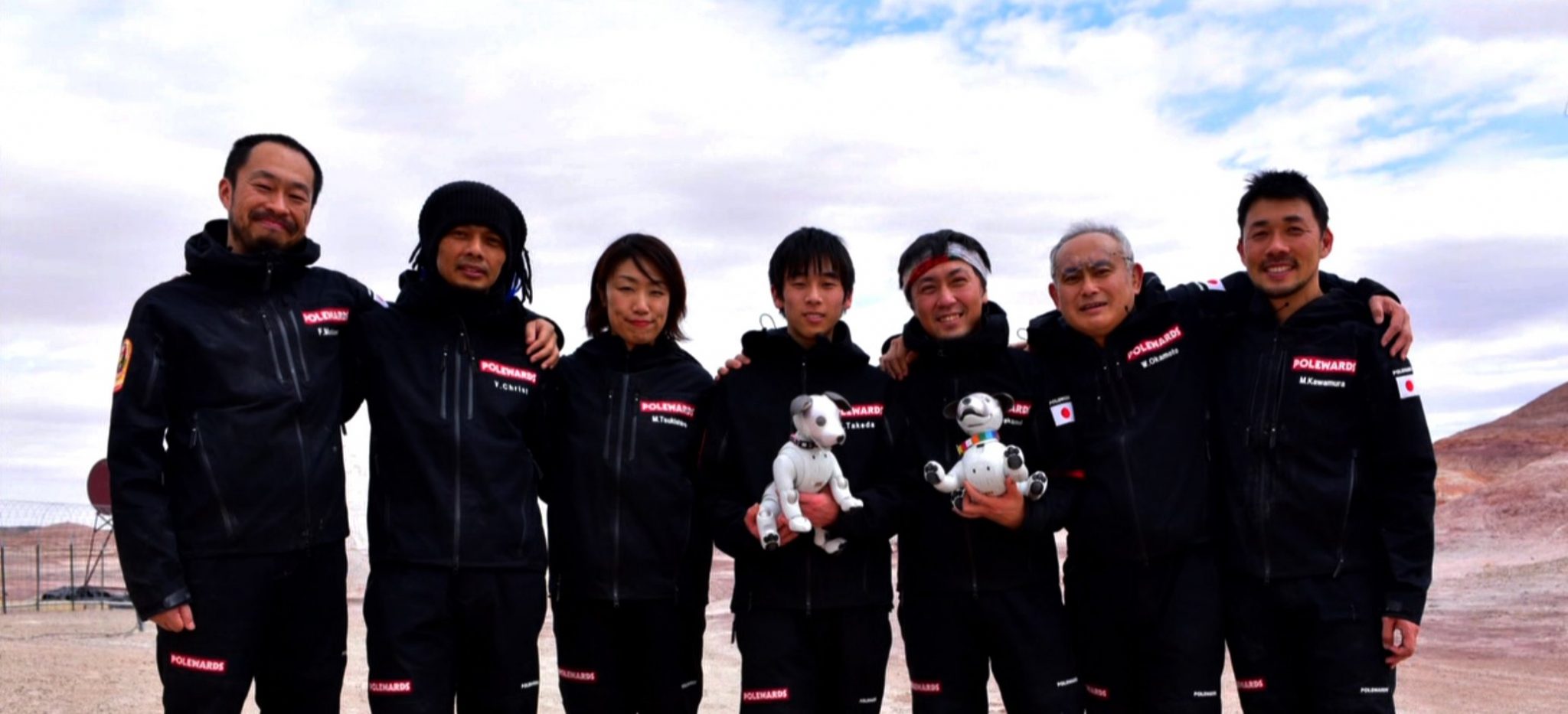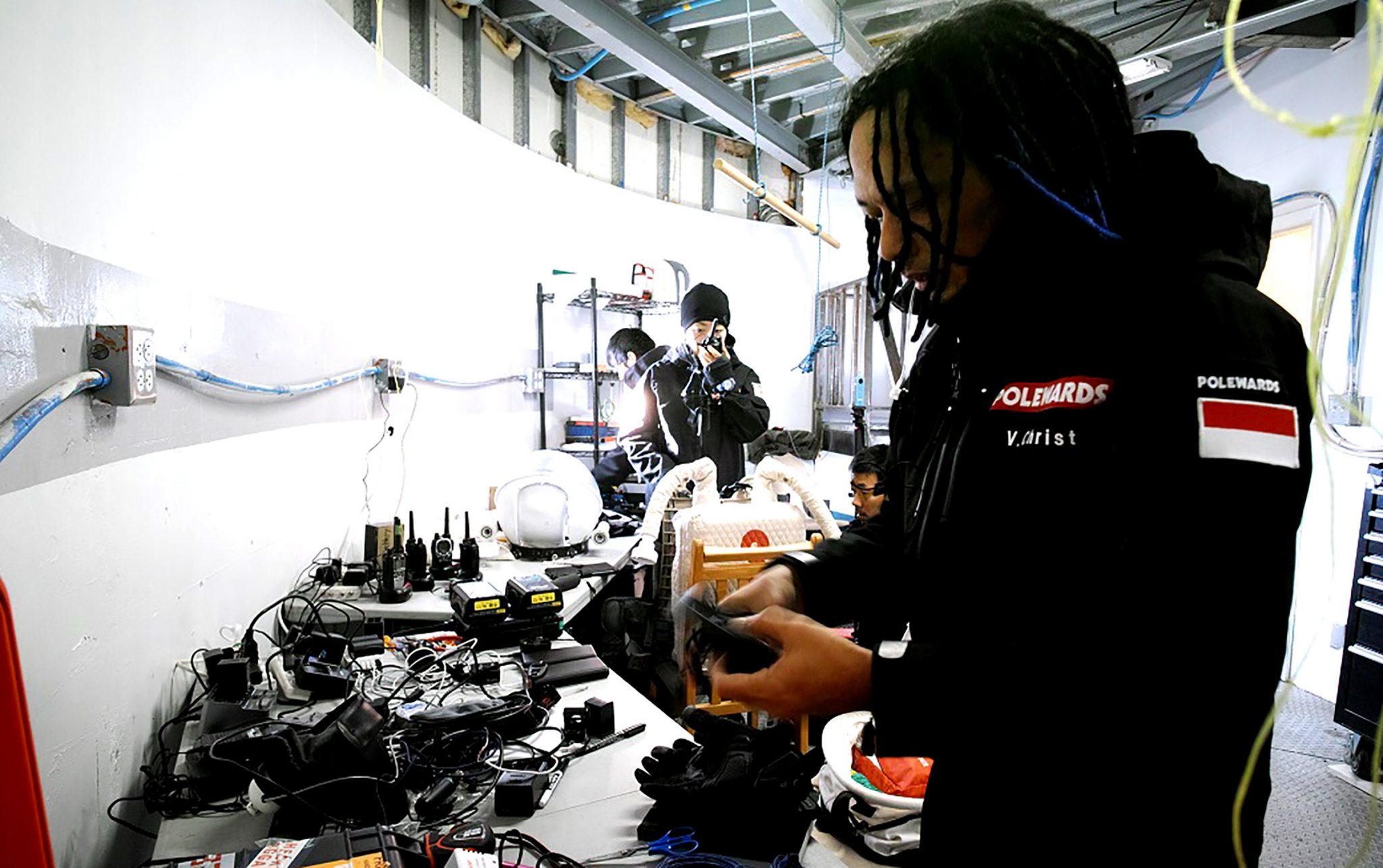MDRS – Mars Desert Research Station

MDRS – Mars Desert Research Station
CREW 191 – TEAM ASIA
made for suitcase transportation
i live in a tiny garage
and I sleep in a robot locker
One night I had a beautiful dream
that my processor got so hot
and I had to reboot
I could feel it glisten and tingle,
and sparkle, and flicker
all the way down
in the system…
(Jens, Oslo, 2015)



MDRS Crew191 TEAM ASIA 2017-2018
JAPAN – INDONESIA
Yusuke Murakami, Miho Tsukishiro, Makoto Kawamura, Fumiei Morisawa,
Venzha Christ, Wataru Okamoto, and Kai Takeda
DREAM AND HOPE from the METAPHOR of MARS
As a small human colony on MDRS right now, we are CREW191 TEAM ASIA, feel like living in the “orbit”. If Earth and Mars had perfectly circular orbits, their minimum distance would always be the same. However, they have elliptical paths, so we are here have a strong connection one and other become a “dream crew” and build an imaginary twin orbit like MARS and Earth. The orbits of Mars and Earth are also slightly tilted with respect to each other. All of these factors mean that not all close encounters are equal.
Fact that we were “FEEL LIKE” living on MARS, because we are! , because we (each of us) had a same plan before arrive in many purpose and directions, its like on MARS it self, we could learn lots of things on MARS (reality) as a (future) second Earth.

Makoto Kawamura thinking like: “pieces of MARS have been found on Earth”, its kind of metaphor, means that as a human we are already connected each other, as a social human being, always think as a colony, as a team, in wider concept of human civilization. Like between MARS and Earth connection, It is believed that trace amounts of the Martian atmosphere were within meteorites that the planet ejected. These meteorites then orbited the solar system for millions of years amongst the other objects and solar debris before eventually entering the Earth’s atmosphere and crashing to the ground.
From that fact, he believe that the “hidden potential” was grow and appear during the MDRS SIM crashing to the new idea and working for “new” potential. He supporting more empowered way of working, removing constraints which may prevent someone doing their job properly.
“MARS experiences huge dust storms – the largest in our solar system”, This is because of the elliptical shape of the MARS planet orbit path around the Sun. The orbit path is more elongated than many of the other planets and this oval shaped orbit results in fierce dust storms that cover the entire planet and can last for many months. Perhaps this idea was bring Wataru Okamoto to create his project, that wrote on the crew191 bio. He want to keep that all those information of the weather during the SIM to be more deep analyzed.
Miho Tsukishiro maybe want to see something in different angle and perspective, she believe that all experience in MDRS were close to “Properly managed”, and try to start with synergistic way of working, where the sum is greater than the parts, as a “the Sun looks about half its size half it does from Earth when seen from MARS”, will be resulting a great balance in our thought future plan… In MARS, this condition will be happen if MARS is closest to the Sun in its orbit the southern hemisphere points toward the Sun and this causes a very short but fiercely hot summer. In the north it experiences a brief but cold winter. When the planet is farthest from the Sun, Mars experiences a long and mild summer because the northern hemisphere points toward the Sun.
Yusuke Murakami as a commander, always trying to do the best as much as he can for this mission, to go up highest zone we can reach, the highest level of how to follow the SIM… He also encourages multi-disciplinary work where teams cut across organizational divides…just remembering of “the tallest mountain known in our solar system is on MARS” named Olympus Mons… It is the tallest mountain in the entire solar system rising to the height of 22km (14 miles) and it is also the largest, youngest active volcano on MARS. While no team ever gets everything it wants, leaders can head off a lot of problems by taking the time to get the essential pieces in place from the start.
Fumiei Morisawa said, as a team : Fosters flexibility and responsiveness, especially the ability to respond to change. As a team we need to respect each other, NOT being selfish or individuals, and in this TEAM ASIA he believe that all we met here must be by some reason, like the reason why MARS have a polar ice cap that these caps are made of carbon dioxide ice as well as water ice. During the southern hemisphere’s summer, much of the ice cap sublimates, a process in which the ice turns straight back into gas, leaving behind what is known as the residual polar ice cap. So “MARS is the only other planet besides Earth that has polar ice caps”. The northern cap is called the Planum Boreum, with Planum Australe in the south. Water ice has also been found under the Martian ice caps.
Kai Takeda is the youngest in TEAM ASIA as a crew, and he like to say that “With the exception of Earth, MARS is the most hospitable to life”. The connection between a GreenHAB at MDRS and also all those activities during the mission are positively make him proud of his project. Like on MARS, we also need to build a real connection between “HUMAN” and “PLANT”…and for the future MARS colony, i think impossible to NOT to drive in this direction…
Venzha Christ agree about “MARS was once believed to be home to intelligent life” because came from the discovery of lines or grooves in the surface called canali by Italian astronomer Giovanni Schiaparelli. He believed that these were not naturally occurring and were proof of intelligent life. However, these were later shown to be an optical illusion.

HABCOM…HABCOM… Can you hear me… (…still whispering on our daily night after “oyasumi” sleeping time…)
When MARS and Earth are close to each other, Mars appears very bright in our sky. It also makes it easier to see with telescopes or the naked eye. The Red Planet comes close enough for exceptional viewing only once or twice every 15 or 17 years. So we are CREW191 TEAM ASIA as a solid team always help each other for daily protocol rules and activities during stay at MDRS. But we need to be focus, discipline, and follow the path of all protocols on MARS mission.
Outer Space
(Tori Hart, 2014)
Bodies soar through Outerspace
Kissing their stars though a little too far to Taste
The Milky Way fell like Silk water falling down our Shoulders
Delicate, Light, and Slick
We are in our own Solar System
Flying circles around our Radiating Sun
As we whisper Buonanotte to that Eternal Night
We shout Buongiorno to the Beautiful new Day.

SPACE IS A DANGER PLACE
We knew, the biological effects of space radiations on astronauts are the main concern in deep space missions. Many investigations have been made to find the best way to overcome those problems in extended space travels. The radiation environment in deep space is several hundred times what it is on Earth, and that’s even inside a shielded spacecraft.
How about this later on?
A new report shows just how dangerous it could be to human brains. Radiation Exposure from a MARS missions could cook brain cells, causing chronic dementia and memory loss, and leaving Astronauts with debilitating anxiety levels, the study has found. This could throw off their thinking and judgment, impairing decision-making and multi-tasking.
But,
From the latest research on this field, scientist said that Radio Frequency Radiation (RFR) can induce Adaptive Response (AR), means that during AR human cells become more resistant to challenging doses’ radiation. Then we can say ; Radio Frequency Radiation can help Astronauts in (during) the space missions.
Exposure to Radio Frequency Radiation before or during space missions while choosing the optimized dosimetric parameters such as determined power density and frequency and duration of exposure can help astronauts in their travels.

In 2012, Hamid Abdollahi, Maryam Teymouri, and Sara Khademi did a deep research about this, including a statement that, Astronauts’ protection against radiation in space is one of the most challenging and complex problems in deep space missions.
Conclusion from their research: “We hypothesize that RFR can be used as a non-genotoxic agent for radiation protection in space. Exposure to RFR along with selecting the best situation to induce the highest AR may help astronauts in space missions. However, more studies are warranted to apply this therapy for space travel. Nevertheless, it will be a good choice for thinking about astronaut’s protection in space missions”.

NOTE – AWARE
Radiation is “a risk we need to learn more about over the next decade so we can do the proper mitigation, so we can do the best we can for the Astronauts who are going to be putting their lives at risk for a number of different threats,” Ron Turner, a senior science adviser at NASA’s Institute for Advanced Concepts in Atlanta. But the optimum solution might be the one that, for now, seems difficult—going faster and avoiding as much radiation as possible. He says, “The best bang for the buck is advanced propulsion, not shielding.”
For example, very large Solar Flares – intense bursts of radiation and particles thrown out by the sun – could cause more damage as these have the power to wipe out electrical equipment and can deliver doses high enough to kill.
Cosmic radiation, which comes from outside our solar system, is harder to protect against and can also constantly pepper the bodies of astronauts, but this can be monitored for and tends occur at a low level.
Even once on the surface of MARS, radiation will still be a problem as the planet’s atmosphere does not offer the same kind of protection as on Earth. Like solar activity, cosmic rays have the potential to cause cancer. These high-energy, high-velocity particles originate from outside the solar system and can severely damage human cells. Unlike radiation from the sun, however, cosmic rays could also spark long-term degenerative effects while still in space, including heart disease, reduced immune system effectiveness and neurological symptoms resembling Alzheimer’s.
“There’s a lot of good science to be done on MARS, but a trip to interplanetary space carries more radiation risk than working in low-Earth orbit,” said Jonathan Pellish, a space radiation engineer at Goddard.“ Ultimately, the solution to radiation will have to be a combination of things,”
Some of the solutions are technology we have already, like hydrogen-rich materials, but some of it will necessarily be cutting edge concepts that we haven’t even thought of yet.
So be aware…


